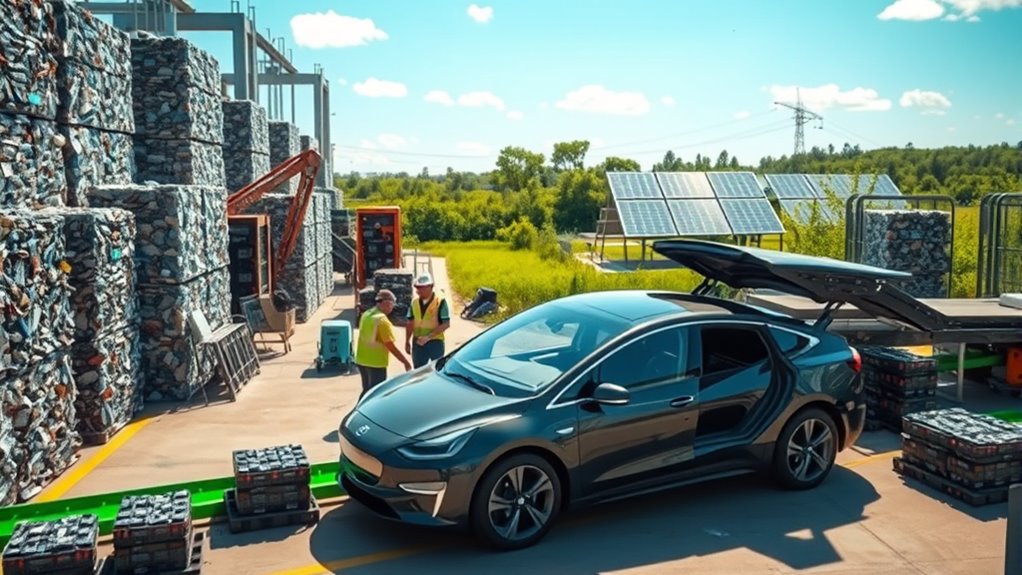Battery recycling and second‑life use greatly boost sustainability by making the most of existing batteries, recovering valuable materials, and reducing waste. When you support these practices, you help extend battery life, lower reliance on finite resources, and cut down environmental harm from mining and disposal. This creates a cleaner planet and a more resilient energy system. Keep exploring to learn how these efforts can further transform our approach to sustainable energy solutions.
Key Takeaways
- Battery recycling recovers valuable materials, reducing reliance on environmentally damaging mining activities.
- Second-life batteries extend usefulness, lowering waste and delaying the need for new battery production.
- Recycling and reuse promote a circular economy, minimizing resource waste and environmental impact.
- Repurposing batteries for stationary storage supports renewable energy integration and grid resilience.
- Overall, these practices decrease carbon emissions and promote sustainable, responsible energy systems.

As the demand for electric vehicles and renewable energy storage grows, battery recycling and second‑life applications have become essential to enhancing sustainability. You can think of it as extending the usefulness of batteries beyond their initial purpose, which directly impacts the battery lifespan and the environment. When batteries reach the end of their primary life, instead of discarding them, you can repurpose or recycle them, thereby *releasing* their remaining capacity. This process not only conserves resources but also reduces the need for mining new raw materials, which can be energy-intensive and environmentally damaging.
By recycling batteries, you’re enabling material recovery, which is *paramount* for sustainability. Many batteries contain valuable metals like lithium, cobalt, and nickel that can be recovered and reused in new batteries or other applications. The more efficiently you recover these materials, the less you depend on extracting virgin resources. This reduces environmental degradation, decreases energy consumption, and lowers carbon emissions associated with mining and processing. As a result, battery recycling becomes a *essential* part of a circular economy, where materials are kept in use for as long as possible, minimizing waste and environmental impact.
Recycling batteries is crucial for recovering valuable metals and promoting a sustainable, circular economy.
Second-life applications amplify this benefit. Instead of letting batteries sit unused after their initial cycle, you can assign them to less demanding roles, such as stationary energy storage for homes or businesses. This approach effectively extends the battery’s useful life, maximizing its value and delaying the need for new batteries. You might not realize it, but repurposing batteries in this way *considerably* reduces waste and conserves resources. It also provides a more affordable energy storage solution, especially in regions where access to new batteries is limited or costly.
The combination of recycling and second-life use fosters a more sustainable approach to energy storage. It helps you address the growing demand for clean energy solutions while mitigating environmental impacts. As you participate in or support these practices, you contribute to a more responsible and resource-efficient industry. You help decrease reliance on finite raw materials and cut down on waste that would otherwise end up in landfills. Ultimately, this means a cleaner planet, a more resilient energy system, and a future where batteries are valued as long-lasting assets rather than disposable products. By prioritizing material recovery and second-life applications, you play a key role in shaping a sustainable energy landscape for generations to come. Additionally, implementing whole-house water filtration systems can further contribute to overall environmental sustainability by reducing the use of bottled water and lowering plastic waste.
Frequently Asked Questions
What Are the Economic Costs of Implementing Large-Scale Battery Recycling?
Implementing large-scale battery recycling involves significant economic costs, as a thorough cost analysis reveals. You’ll face expenses related to establishing recycling facilities, developing advanced technologies, and training personnel. However, economic incentives like government subsidies and potential profit from recovered materials can offset these costs. While upfront investments are high, the long-term savings and environmental benefits make this approach financially worthwhile, encouraging you to adopt sustainable practices.
How Do Second-Life Batteries Compare Performance-Wise to New Batteries?
Second-life batteries generally offer good performance, but they don’t match new batteries regarding capacity and efficiency. You might notice slightly reduced battery longevity, which means they may need replacement sooner. However, for many applications like energy storage or backup power, second-life batteries can be a cost-effective and sustainable option. Their performance is sufficient for less demanding uses, making them a practical choice when balancing cost and functionality.
What Are the Potential Environmental Risks of Improper Battery Recycling?
If you mishandle battery recycling, you risk unleashing hazardous waste that could cause soil contamination—a disaster of epic proportions! Improper recycling can release toxic chemicals and heavy metals into the environment, posing serious health risks and harming ecosystems. You must guarantee proper disposal and recycling practices to prevent these dangers. Responsible recycling safeguards the environment, protecting soil and water from contamination and helping to maintain a healthier planet for everyone.
How Does Battery Recycling Impact Global Supply Chains?
Battery recycling strengthens your supply chain resilience by reducing dependency on raw material sourcing, which can be disrupted by geopolitical issues or resource scarcity. It allows you to reuse valuable materials like lithium and cobalt, ensuring a more stable supply. This process also shortens lead times and minimizes costs, helping your operations stay flexible and sustainable in a competitive market. Recycling consequently plays a vital role in maintaining a resilient, efficient supply chain.
What Policies Are Most Effective in Encouraging Battery Reuse and Recycling?
Think of policies as the compass guiding you toward sustainability. Consumer incentives like rebates and discounts act as magnets, drawing people into recycling programs. Strong regulatory frameworks set clear rules and standards, ensuring companies prioritize reuse and recycling. When these policies work together, they create a ripple effect, transforming waste into valuable resources and making sustainable practices the new normal, all while you play an essential role in protecting the planet.
Conclusion
By embracing battery recycling and second-life applications, you help reduce environmental harm and conserve resources. For instance, imagine repurposing EV batteries for home energy storage, extending their usefulness and lowering waste. This approach not only cuts down on mining but also promotes a circular economy. If more people and companies adopt these practices, you can play an essential role in building a sustainable future where batteries serve longer and impact less on our planet.









